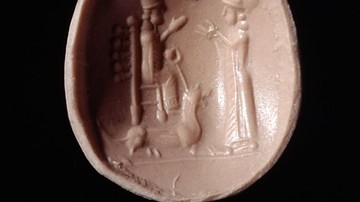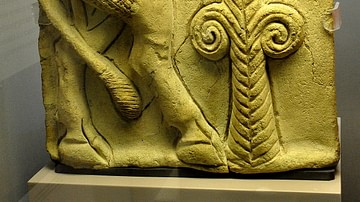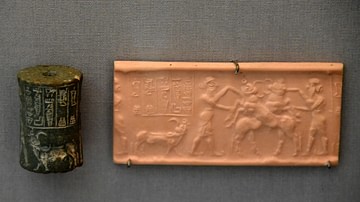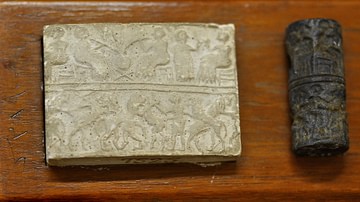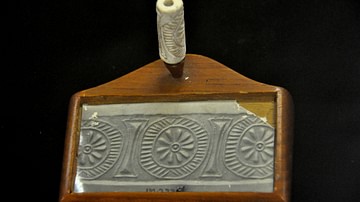Illustration
Grey or brown chalcedony cylinder seal in the modelled style; a bearded god (Ninurta), wearing a square, star-topped, horned head-dress and a vertically striated, tiered, fringed open robe over a fringed kilt, with a star-tipped crossed bow-cases on his back, a sword at his belt, and a sickle-sword hanging from his right arm, draws a star-studded bow and aims an arrow at a rampant lion-griffin. He strides towards the right on the back of a charging, scorpion-tailed lion-griffin, resting one foot on its bull's horns and the other on one of its hind legs; it has lion's paws and from its jaws issues a triple-forked tongue or, more probably, the end of the thunderbolt with which the god has defeated it. The rampant lion-griffin flees towards the right but looks back towards the pursuing god; it has prickled ears rather than a horn, and no evidence of a tongue, outstretched lion's forelegs with claws extended, spread wings and a bird's tail, hind legs, and talons; on either side of its head are the Pleiades (or seven dots symbol of the Sibitti group of deities) and the crescent.
A subsidiary scene has been inserted at the end of the main scene. A small, bearded worshipper, wearing a fringed robe, stands facing right, points with his raised right hand, and extends the other. Behind him is a slightly curved, vertical ball-and-staff, and in front of him, facing left is a small dog, sitting on its haunches; at a higher level, also facing left, sits the goddess Gula, wearing a square, star-topped, horned head-dress and a vertically-striated, tiered, fringed robe; she holds a scalpel in her raised right hand and a beaded ring in the other. Her star-backed chair (throne?), with elaborately turned legs and double stretchers, rests on the back of a couchant dog with a curled tail. Line borders at the top and bottom. Some small chips.
The British Museum, London.
Cite This Work
APA Style
Museum, T. T. o. t. B. (2017, February 01). Cylinder Seal with Ninurta. World History Encyclopedia. Retrieved from https://www.worldhistory.org/image/6317/cylinder-seal-with-ninurta/
Chicago Style
Museum, The Trustees of the British. "Cylinder Seal with Ninurta." World History Encyclopedia. Last modified February 01, 2017. https://www.worldhistory.org/image/6317/cylinder-seal-with-ninurta/.
MLA Style
Museum, The Trustees of the British. "Cylinder Seal with Ninurta." World History Encyclopedia. World History Encyclopedia, 01 Feb 2017, https://www.worldhistory.org/image/6317/cylinder-seal-with-ninurta/. Web. 18 Apr 2025.

